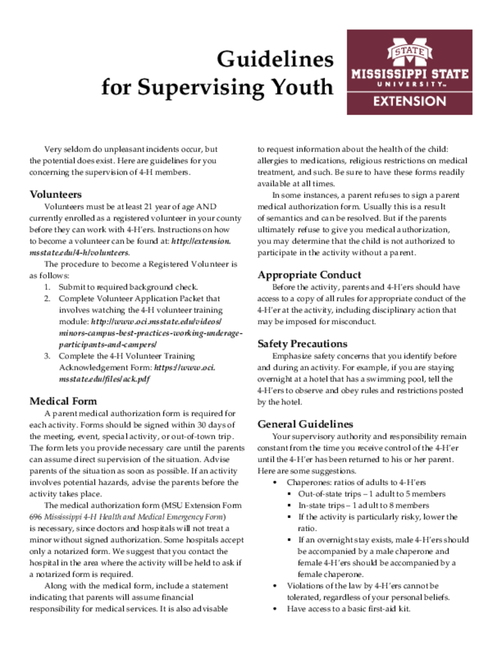Guidelines for Supervising Youth
Very seldom do unpleasant incidents occur, but the potential does exist. Here are the guidelines for you concerning the supervision of 4-H youth.
Volunteers
Volunteers must be at least 21 year of age AND currently enrolled as a registered volunteer in your county before they can work with 4-H’ers. Find instructions on how to become a volunteer.
The procedure to become a Registered Volunteer is as follows:
- Submit to required background check.
- Complete Volunteer Application Packet that involves watching the 4-H volunteer training module.
- Complete the 4-H Volunteer Training Acknowledgement Form.
Medical Form
A parent medical authorization form is required for each activity. Forms should be signed within 30 days of the meeting, event, special activities, or out-of-town trips. The form lets you provide necessary care until the parents can assume direct supervision of the situation. Advise parents of the situation as soon as possible. If an activity involves potential hazards, advise the parents before the activity takes place.
The medical authorization form (Extension Form 696, 4-H Events Health & Medical Emergency Form) is necessary, since doctors and hospitals will not treat a minor without signed authorization. Some hospitals accept only a notarized form. We suggest that you contact the hospital in the area where the activity will be held to ask if a notarized form is required.
Along with the medical form, include a statement that parents will assume financial responsibility for medical services. It is also advisable to request information about the health of the child: allergies to medication(s), religious restrictions on medical treatment, and such. Be sure to have these forms readily available at all times.
In some instances, a parent refuses to sign a parent medical authorization form. Usually this is a result of semantics and can be resolved. But if the parents ultimately refuse to give you medical authorization, you may determine that the child is not authorized to participate in the activity without a parent.
Appropriate Conduct
Before the activity, parents and 4-H’ers should have access to a copy of all rules for appropriate conduct of the 4-H’er at the activity, including disciplinary action that may be imposed for misconduct.
Safety Precautions
Emphasize to the youth safety concerns that you identify before and during an activity. For example, if you are staying overnight at a motel that has a swimming pool, tell the 4-H’ers to observe and obey rules and restrictions posted by the motel.
General Guidelines
Your supervisory authority and responsibility remain constant from the time you receive control of the 4-H’er until the 4-H’er has been returned to his or her parent. Here are some suggestions.
- Chaperones: ratios of adults to 4-H’ers:
- Out of state trips – 1 adult to 5 members
- In-state trips – 1 adult to 8 members
- If the activity is particularly risky, lower the ratio.
- If an overnight stay exists, male 4-H’ers should be accompanied by a male chaperone and female 4-H’ers should be accompanied by a female chaperone.
- Violations of the law by 4-H’ers cannot be tolerated, regardless of your personal beliefs.
- Have access to a basic first-aid kit.
- All drivers of vehicles involved in the activity must be adults (someone who is 21 or older). Consider using public transportation whenever practical.
- Do not use physical punishment. Return youth to their parents if a major problem develops.
- Do not use alcohol or tobacco when accompaning youth.
Incidents
If an incident occurs, you will be faced with two immediate concerns: proper care and concern for any injured person and proper supervision of the group. Basic first aid certification can be extremely helpful. Common sense is appropriate in determining whether medical or police authorities should be contacted. You will need to assign someone to supervise the remainder of the group while you are helping an injured person. For this reason, we suggest that at least two adults accompany groups on hikes or similar activities.
After an incident, notify your supervisors as soon as is reasonably possible and follow their instructions. Also, notify the state 4-H program leader at the earliest possible time.
- Write down names and addresses of all persons who witnessed the incident and of others (such as police) who became involved.
- Note the time and exact location of the incident and any other factors that might have affected the incident.
- Assemble any written information used in plan ning and conducting the activity. Make note of instructions that were given—what was said, when, where, and to whom.
- Maintain a file with this information until you are advised by an appropriate authority that it is no longer needed.
- If you or your county 4-H program carries liability insurance, notify the insurance company as soon as possible and follow their instructions.
Always use courtesy and consideration when contacting the family of the 4-H’ers involved in the incident.
- Notify the family as soon as possible and take a sincere interest in the situation.
- Should the family be hostile toward you, advise your supervisor, the state 4-H program leader, and the insurance company, and follow their instructions.
- Have another adult present when you contact the family.
- Report facts to the family; do not include conclusions or opinions, such as who you believe was at fault.
Summary
In supervising youth, use common sense. No list of instructions could cover all the circumstances you might face. Your challenge is to supervise them. Although the information presented here comes from reliable sources, we recommend that you consult with your supervisor or your own legal counsel on specific issues.
